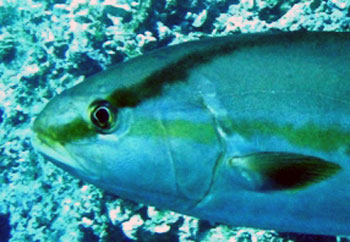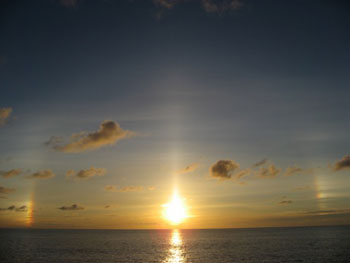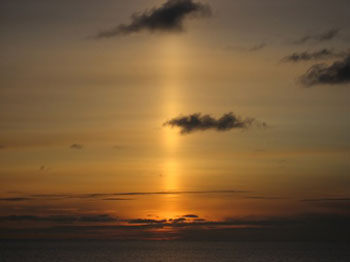|
You
are here: /main/research
expeditions/June-July
2006/ Day 18
The Kahala as an `Aumakua?
Paulo Maurin, University of Hawai`i
In collaboration with Ellyn Tong, Hawai`i Audubon Society
Sometimes we perceive particular experiences in a certain way, only to have our initial view of those
events evolve when we gain new insights. This way, we can discover that what we initially thought of to
be negative experiences, after a reflective pause, can turn out to be entirely different. A few days
ago, I had such experience, involving a kahala.

The
kahala, or amberjack, making a close appearance. Photo: Paulo Maurin
The kahala, or amberjack, is a fish of the jack family, which includes the ulua
(giant trevally) species, which are not an uncommon sight in the Northwestern Hawaiian Islands.
The amberjack is a large predatory fish, which can grow to almost six feet in length. It is mostly
silver, with a diagonal line that runs from both sides of the upper lip, seemingly through the eye
and into running towards the dorsal fin on top. This line can become darker as the fish gets
excited or agitated.
While snorkeling the outer reef area on the Northeast side of Kure Atoll, we had seen four species of
jacks within a short time span – giant trevally, thicklipped trevally, the iridescent bluefin trevally,
a black trevally and, finally the fifth jack appeared, an amberjack. To honor this variety of top-level
predators, we called this site “Jackson Five.” It is a severe spur-and-groove reef, an area full of
channels that rise from the deep and meet the outer perimeter of the atoll, with exposed rocks providing
an outline. In between the grooves there are large, narrow rocky spurs with a varied geometry that would
keep a diligent ocean mapper occupied for some time. These channels leading to the deeper parts of the
ocean allow larger, pelagic animals to approach the atolls and its abundant life with ease.
After having seen the first of four species of jacks, the kahala made its appearance,
measuring about four feet in length. It first closely checked out the first two snorklers, then coming
to me for what at first seemed like another regular inspection of new, strange intruders within its
territory. But it had a dark, well-defined line crossing its resolute eyes, a telltale sign of its
agitated state. It quickly became clear that this was no ordinary inspection. The kahala
started displaying a very aggressive behavior, repeatedly lunging at my fins and feet. I would try to
scare it away with futile kicks that the fish, no matter how quick I was, managed to dodge with ease
every time. If the situation at first appeared somewhat comic, the determination of an unexpected
adversary quickly made me realize that there could be some danger to it – not life-threatening, but the
fish was able to deliver an unwelcome bite. For three full minutes the fish kept circling me, launching
quick attacks.

A close up of the kahala, with the black line visible. Photo: Paulo Maurin.
After it became apparent that this kahala was unlikely to be deterred by soft
silicone fins, I called the nearby zodiac boat to come and, yes, I admit, rescue me from a fish
that was not even a shark. Being rescued from an attacking shark requires no explanation and commands
immediate awe upon any audience. Any other fish, no matter which kind, tends to require a bit of an
explanation in order for the rescue to be justified to more incredulous listeners.
It soon became evident, however, that we were all indeed in need of rescue, not from the kahala itself but from a less visible but more numerous and menacing threat. Immediately after boarding
the boat (an operation that took very little time, I may add), the idle zodiac drifted a few yards.
It was then when we noticed that we were surrounded by sea jellies. Numbering in the hundreds,
a swarm of harmless ctenophores and very painful box jellyfish dotted the surface, abundant as
snowflakes during a winter storm.
Later that day during sunset I was reflecting upon that experience. I was fixated on seeing the kahalaas the threat of the day, not realizing that, without it, we would have swam to the boat instead of
calling the boat towards us. We would have inevitably passed by this thick mass of jellies, a painful
experience. I recalled then reading about two boys who were free diving far from the South Point of
Big Island, Hawai`i. A very large shark appeared next to them, and realizing the danger, immediately
started swimming back. They had to fight a very strong current that was pulling out to sea but,
motivated by a trailing shark that never left their side, they reached the shore exhausted. When
recounting the story to an elder, he told then it was the shark that took them out of the sea in time,
before the current could have pulled them both. The kahala’s insistence prompted us to get out of the
water, just in time to avoid massive encounters with sea jellies.
In Hawaiian culture, there is the belief that certain elements of nature can be channels for the Gods to
manifest themselves. The belief of the `aumakua, personal or family gods, runs deep in these
blessed lands. These gods can take the form of certain animals that are sacred to that person or
family, and their presence is sought for festivity as well as times of crisis. Author Keone Nunes
says that `aumakua can act as healers, counteracting troubles and punishing faults. The
kahala itself was associated with the chiefs, with a Hawaiian proverb that says “it went
straight to the mouth of the kahala,” meaning that something went straight to the chief (Titcomb).
The powerful kahala certainly fits the royal part.

A “sunbow,” a
rainbow without the rain, was the show of the night.
Note the large arc of light
around the sun. Photo: Paulo Maurin.
As if to set the right context for reflecting upon that day’s experience, the sunset that afternoon was
something to behold - a very unique sunset which I might have seen only a couple of other times before
in my life. A “sunbow” formed that afternoon, in a late sunset occurring close to three hours before
midnight. A large arc of light formed around the sun, only whose ends, anchored at sea, were visible.
I lack the meteorological knowledge to describe the physical process that makes this rare occurrence
possible. But it was hard to deny that it was a special moment. As the sun was about to dip under
the horizon its last ray of light was a single beam, omen-like, that projected straight up to the
heavens. A magnificent end to a meaningful day.

At the end of the sunset, the last part of the sunset became a single
ray of light shining straight up from the sun. Photo: Paulo Maurin.
Books cited:
Nunes, Keone (2003). Investigation of the Cultural Importance of
Sharks to the Indigenous People of the U.S. Flag Areas in Central and Western
Pacific. Hawai`i Audubon Society. Honolulu.
Titcomb,
Margaret (1977). Hawaiian Uses of Fish. University of Hawai`i Press: Honolulu.
|